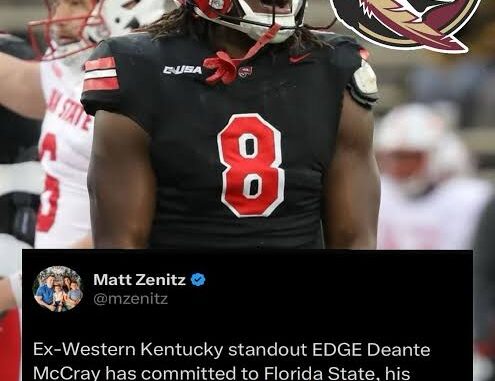
In an unexpected turn of events, Tyeland Coleman, a rising star in collegiate sports, alongside two other elite transfers, has shocked the NCAA landscape by rejecting their departure despite the whirlwind of offers from high-profile programs. Their decisions have sparked a major uproar in the NCAA Transfer Portal, further intensifying the ongoing debate about athlete mobility, transfer rights, and the evolving nature of college sports contracts.
Tyeland Coleman: The High-Profile Reject
Tyeland Coleman, a standout talent who had been a key figure in the NCAA transfer market, was expected to make a move to a powerhouse program this offseason. As a top-tier athlete with considerable potential, his name was widely linked with multiple suitors eager to secure his services. However, much to the surprise of fans and experts alike, Coleman made the bold decision to stay at his current program.
Coleman’s rejection of lucrative offers comes at a time when the NCAA’s transfer system is in a state of flux, with more athletes than ever before opting for the transfer portal in search of better opportunities. Coleman’s stance, however, signals a shift in how players approach their future, showing that some may be prioritizing stability, loyalty, or a sense of unfinished business over the promise of greener pastures elsewhere.
“After deep thought and discussions with my coaches and family, I’ve chosen to remain here and finish what I’ve started,” Coleman said in an official statement. “I believe in the vision of this program and the work we’ve been putting in together. I’m excited for what the future holds here.”
The Elite Transfers Who Followed Suit
Coleman isn’t alone in rejecting the allure of big-money moves. Two other elite athletes, both with standout performances in their respective seasons, also opted to stay with their current teams. These transfers, who had recently joined their respective programs amid much fanfare, turned down highly attractive offers from rival schools in favor of maintaining their current commitments.
The wide receiver, who was one of the most sought-after players after his breakout season, chose to remain with his current team, citing strong relationships with the coaching staff and a desire to lead the program to further success. “This team feels like family, and we have unfinished goals to achieve,” he remarked, making it clear that his decision was driven by a deep connection with his teammates and coaching staff.
Similarly, a highly recruited defensive lineman who had transferred earlier in the offseason surprised many by rejecting a lucrative offer from a rival powerhouse. His focus, he explained, was on the culture and future of his current team. “It’s not just about where you play; it’s about who you play with,” he explained. “I feel there’s a special bond here, and I want to be a part of the team’s success.”
The Uproar in the NCAA Transfer Portal
The rejections from these high-profile athletes have ignited an uproar in the NCAA Transfer Portal, drawing attention to the complexities of modern college sports. In recent years, the NCAA’s transfer portal system has empowered athletes to move freely between programs, providing more opportunities for players to find the right fit. However, this newfound freedom has led to controversy and confusion, particularly around player contracts and the relationships between athletes and schools.
Many critics of the system have expressed concerns about the lack of clear structure regarding contract obligations. With players able to leave programs at will, schools often find themselves scrambling to adjust to the unpredictable nature of the portal. These rejections are a reflection of that uncertainty, as institutions are left grappling with the fluidity of the player market and the changing expectations of their athletes.
The controversy stems from a wider conversation about the balance of power between athletes and programs. For schools, the inability to predict whether a player will stay or go makes long-term planning difficult. On the other hand, athletes like Coleman and the two elite transfers are challenging the notion that they should be bound by rigid contract structures, especially when those contracts may not align with their personal goals or the program’s direction.
What’s Next for the NCAA Transfer Portal?
The events surrounding Tyeland Coleman and his fellow athletes are indicative of a larger shift in how collegiate athletes view their roles within the NCAA. While many have embraced the freedom of movement provided by the transfer portal, others are taking a more measured approach, opting to stay with the programs that offered them opportunities in the first place. This evolving dynamic is reshaping the NCAA’s recruiting and transfer policies, calling for a reevaluation of how the portal is used and how contracts should be structured moving forward.
In the wake of this uproar, there are growing calls for reform. Experts suggest that clearer regulations surrounding player contracts, transfer eligibility, and program commitments are needed to create a more stable environment for both athletes and schools. As the NCAA grapples with these issues, the recent decisions by Coleman and the other elite transfers may serve as a catalyst for change.
A New Era of Athlete Empowerment
At the core of this discussion is the growing empowerment of college athletes. The decisions of Coleman and his peers highlight a shift in the mindset of student-athletes, who are now in a position to have more control over their futures than ever before. Whether this signals the beginning of a more player-centric model or simply a temporary shift remains to be seen, but it is clear that the NCAA is undergoing a transformation.
As the dust settles on this contract uproar, it is evident that the landscape of college athletics is changing. Tyeland Coleman and his fellow transfers have set a new precedent for how athletes navigate the transfer portal, and their choices may ultimately play a role in shaping the future of college sports for years to come.
Leave a Reply